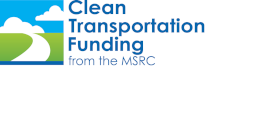The Mobile Source Air Pollution Reduction Review Committee (MSRC) has $20 million in Clean Transportation Funding available for warehouses, distribution centers and intermodal facilities located in the Inland Empire to reduce vehicle emissions from their goods movement operations. There are two opportunities for zero- and near-zero vehicles and supporting infrastructure – one for on-road trucks and one for cargo-handling equipment.
The MSRC is offering up to $14 million to eligible entities that frequently transport goods to warehouses and distribution centers in Riverside and San Bernardino Counties using heavy-duty Class 7 or 8 trucks. Funding can be used to purchase or lease new, on-road heavy-duty trucks that are zero-emission, such as battery-electric or fuel cell vehicles, or equipped with near-zero emission engines certified by the California Air Resources Board at the Optional Low-NOx Certification standard of 0.02 g/bhp-hr or cleaner. Electric charging, hydrogen refueling, and renewable natural gas refueling infrastructure for these vehicles also are eligible for funding.
For off-road cargo-handling equipment, the MSRC is offering up to $6 million to purchase zero- and near-zero equipment used to move shipping containers or bulk materials onsite at Inland Empire freight facilities. Examples of eligible equipment include yard tractors (hostlers), top picks, and side loaders. Additionally, supporting refueling infrastructure is eligible for funding.
“Cleaning up the goods movement industry, especially transforming the heavy-duty diesel truck fleets that transport goods from our local ports, is essential to meeting the region’s air quality goals,” explained Larry McCallon, MSRC Chair and Mayor of the City of Highland. “The MSRC is excited to offer this funding to operations in the Inland Empire to help them with their clean air projects.”
About 70 percent of the containerized cargo that moves through the Los Angeles and Long Beach Ports travels by heavy-duty diesel trucks through the South Coast basin, where 40 percent of it ends up in warehouses, distribution centers, and logistics facilities in Riverside and San Bernardino Counties. There are more than 400 such facilities in the Inland Empire. According to the Southern California Association of Governments, goods movement operations are responsible for approximately 47 percent of all NOx emissions, and about 18 percent of all PM2.5 emissions in the South Coast Air Basin. Heavy-duty trucks account for about 75 percent of NOx emissions and 61 percent the PM2.5 emissions from goods movement sources in Southern California.
The MSRC is offering this funding via a competitive request for proposal process. An online bidders’ conference will be held on November 18, and proposals must be submitted electronically to the MSRC by January 15, 2021.
For more information, please visit the MSRC’s website at www.CleanTransportationFunding.org
Since 1990, the MSRC has allocated Clean Transportation Funding from a $4 surcharge on vehicle license fees, specifically to be used for local projects designed to reduce air pollution from mobile sources such as cars, trucks and buses. Thirty cents of every surcharge dollar goes into the MSRC fund. More than $450 million has been distributed for air pollution-reduction programs throughout LA, Orange, Riverside and San Bernardino Counties that have helped to remove as much as 13,000 tons of air pollution from the skies of Southern California. Clean Transportation Funding is heavily leveraged with investments from government agencies, as well as private sources, with billions of additional dollars contributed to projects throughout the region.
Membership of the MSRC is made up of representatives from the transportation agencies of Los Angeles, Orange, Riverside, and San Bernardino Counties as well as the Southern California Association of Governments, a designated regional rideshare agency, the California Air Resources Board and the South Coast Air Quality Management District.
